|
|
| |
 |
|
| |
 Eaton's
Fall/Winter Catalogue, 1958-59, p. 540. Eaton's
Fall/Winter Catalogue, 1958-59, p. 540.
|
|
| |
|
|
|
Professional Hockey and the Mail-order Catalogue
by John
Willis
By convention, hockey is Canada's national sport.
Hockey
is central to how Canadian men and women view themselves in terms of
sports excellence.
Originally an amateur sport, the game has become a business in which
investment,
marketing, and communication play major roles. The mail-order catalogue
was part
and parcel of the business of making hockey popular for it contributed to
the
emergence of professional hockey stars. Hockey players first appeared in
catalogues
during the 1930s. Two decades later, a very special hockey star became a
well-known
commodity of mail-order merchandising. His name was Maurice Richard.
Early Years of Hockey
| Professional Hockey
| Selling Hockey | Stardom and the Catalogue
| Further Reading
|
| |
| |
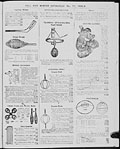 |
|
| |
 Eaton's
Fall/Winter Catalogue, 1905-06, p. 243 (detail). Eaton's
Fall/Winter Catalogue, 1905-06, p. 243 (detail).
|
|
| |
|
|
|
Early Years of Hockey
Hockey began in Canada as an amateur sport. University students and
members
of amateur athletic organizations played the game outdoors — not in
an
arena. (Even during the early years of professional hockey, the playoffs
were
still taking place outdoors.
| |
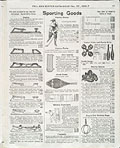 |
|
| |
 Eaton's
Fall/Winter Catalogue, 1906-07, p. 161. Eaton's
Fall/Winter Catalogue, 1906-07, p. 161.
|
|
| |
|
|
|
During a spring thaw, sawdust was sprinkled over areas of unsure ice to
protect
players from breaking through the surface. Skaters dashed madly up the ice
only
to lose the puck in a ball of slush.) Although amateur in status, hockey
was
increasingly recognized as a popular team sport with a standard set of
rules
and equipment requirements.
| |
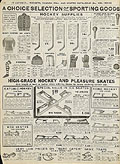 |
|
| |
 Eaton's
Fall/Winter Catalogue, 1912-13, p. 162. Eaton's
Fall/Winter Catalogue, 1912-13, p. 162.
|
|
| |
|
|
|
As amateur hockey gained in popularity, especially among young
athletes, the
game began to show up in mail-order catalogues. Early Eaton's
catalogues
contain small and vague depictions of people playing hockey outdoors;
sticks
and skates were shown. The 1912-13 catalogue devoted an entire page
to
hockey including the first visual representations of protective equipment.
During
the 1910s, the Eaton's catalogue offered to outfit entire hockey
teams
with sweaters, socks, regulation nets, and everything else down to the
referees'
whistles.
|
Professional Hockey
| |
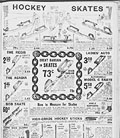 |
|
| |
 Eaton's
Fall/Winter Catalogue, 1917-18, p. 303. Eaton's
Fall/Winter Catalogue, 1917-18, p. 303.
|
|
| |
|
|
|
In November 1917, five entrepreneurs met at the Windsor Hotel in
Montréal
to form the National Hockey League (NHL), a new professional hockey
association.
In the process, they dispensed with the Toronto franchise, the Blueshirts,
and
its owner E. J. Livingston. Having achieved this, one of the NHL founders,
Tommy
Gorman of the Ottawa team, allegedly remarked: "Now we can get on
with
the business of making money." This, the NHL set out to do during
the 1920s.
NHL teams began using artificial ice surfaces and indoor arenas to
extend
the hockey season and maximize gate receipts. The Ottawa Auditorium was
built
for the Ottawa Senators in 1923. It was a 10 000-seat facility. The
Montreal
Forum was built at a cost of $1 million the following year in 1924. Maple
Leaf
Gardens in Toronto was completed by November 1931 and cost $5 million.
Competing
leagues in Western Canada were put out of business. Expansion into
big-city American
markets was initiated. Boston, New York, Pittsburgh, Detroit, and Chicago
were
all awarded franchises and brought into the league by 1927. In the U.S., a
series
of arenas (Boston Garden, Madison Square Gardens, and Chicago Stadium) was
built
to accommodate the thousands of fans willing to pay to attend a game.
| |
 |
|
| |
 Eaton's
Fall/Winter Catalogue, 1934-35, p. 268. Eaton's
Fall/Winter Catalogue, 1934-35, p. 268.
|
|
| |
|
|
|
In the U.S. and Canada, filling these arenas was a business
proposition. The
Montreal Arena Company, owners of the Montreal Forum, also owned the
city's
two hockey teams: the Montréal Canadiens and the Montreal Maroons
(1925-1938).
They had the best of both worlds: The Canadiens were popular with the
francophone
market and the Maroons were the favourite of English Montrealers. During
the
1920s, the success of these two teams and the rivalry between them did
much to
popularize the sport of professional ice hockey in Montréal. During
five
of the six seasons between 1924 and 1930, one or other of the two found
themselves
in the Stanley Cup playoffs.
| |
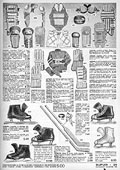 |
|
| |
 Dupuis
Frères Mid-winter Catalogue, 1949, p. 29. Dupuis
Frères Mid-winter Catalogue, 1949, p. 29.
|
|
| |
|
|
|
In the midst of the Depression, around 1937, the Montreal Arena Company
fell
into debt. The company rationalized by sacrificing the Maroons in 1938.
Team
star Toe Blake was transferred to the Canadiens. Now known as the Habs,
the Canadiens
became the only show in town, Montréal became a single-team market,
and
many Montrealers had to transfer their hockey allegiance to the other side
of
Montreal's linguistic barrier. The stage was set for a new era of
selling
hockey.
|
Selling Hockey
| |
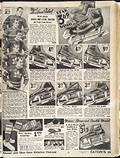 |
|
| |
 Eaton's
Fall/Winter Catalogue, 1935-36, p. 269. Eaton's
Fall/Winter Catalogue, 1935-36, p. 269.
|
|
| |
|
|
|
Hockey owners and entrepreneurs in the NHL deployed a number of tools
to promote
the fortunes of their teams. The key challenge was to ensure the loyalty
of the
public, who attended game after game and bought from the team and its
sponsors.
First and foremost in the arts of persuasion were the instruments of
communication.
Newspaper reporters functioned as adjunct members of the team. They were
spoon-fed
a continuous diet of press communiqués, background material, and
team
trivia, which they, in turn, served up to the public. An effective public
relations
tool that generated newspaper copy and focused attention on the home team
during
preseason play was the training camp, an invention of the Maple
Leafs'
organization during the 1930s.
| |
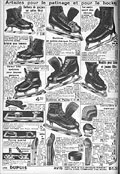 |
|
| |
 Dupuis
Frères Fall/Winter Catalogue, 1930-31, p. 216. Dupuis
Frères Fall/Winter Catalogue, 1930-31, p. 216.
|
|
| |
|
|
|
A powerful means of popularizing hockey emerged during the late 1920s
and
early 1930s: radio. Foster Hewitt began broadcasting Leaf games live for
the
Toronto radio station CFCA. By the early 1930s, the games were broadcast
in Montréal.
By 1933, Hewitt was broadcasting to a coast-to-coast, English-speaking
market
on a 20-station radio network. At first, General Motors sponsored the
broadcasts.
In 1936, Imperial Oil took the lead in sponsoring hockey.
In Canada as in the U.S., the 1930s marked the commercialization of
radio.
Radio programs and the products they peddled on behalf of their sponsors
burrowed
into the inner reaches of North American family life, and, not just in the
home.
By the late 1930s, radios began showing up in cars. Automobile travellers
could
thus treat themselves to the ultimate experience of listening to a game,
fantasizing
about what was happening on the ice as they continued on their journey.
The single most powerful means of selling hockey was the institution of
stardom.
The renown of the star players exceeded that of the entire team and came
to characterize
hockey most powerfully, as in the case of Howie Morenz, star and homme
fatal
of the Canadiens in the 1920s and 1930s. His dramatic injury and death in
January
1937 was a huge public event in Montréal. Morenz was mourned as a
much
loved public celebrity, a first-rate star.
| |
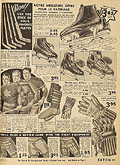 |
|
| |
 Eaton's
Fall/Winter Catalogue, 1933-34, p. 297. Eaton's
Fall/Winter Catalogue, 1933-34, p. 297.
|
|
| |
|
|
|
Live radio broadcast no doubt facilitated hockey stardom, but, without
considerable
investment, no significant outlays on key players could occur. In 1930,
the popular
Ottawa Senators player King Clancy was acquired by the Toronto Maple Leafs
for
the unprecedented sum of $35 000. Clancy thus joined a team whose
"stars"
would achieve considerable renown during the 1930s. Among these stars were
the
three members of the kid line: Charlie Conacher, Busher Jackson, and Joe
Primeau.
Other Leaf stars popularized during the 1930s were Syl Apps and Red
Horner, the
archtypical hard-nosed defenceman. Apps was a track-and-field athlete in
his
own right who played on and off for the Leafs from 1936-1948. Horner
was
the most penalized player in the league for eight of his twelve seasons
(1928-1940).
| |
 |
|
| |
 Simpson's
Fall/Winter Catalogue, 1940-41, p. 330. Simpson's
Fall/Winter Catalogue, 1940-41, p. 330.
|
|
| |
|
|
|
These players were the historical bedrock of NHL stardom. They were the
first
and, for that reason, the class of the 1930s and 1940s is fondly
remembered.
It was no coincidence that the custom of numbering hockey sweaters was
introduced
during the 1930s: The object was to make individual players more
recognizable.
The cult of stardom was thus firmly established.
Hockey was by no means the only sport to make use of stardom; boxing
and baseball,
as well as the rodeo in the West, immediately come to mind. Moreover, the
analogies
with the movie business during the 1930s are striking.
Stars are as old as the movies. However, stardom, according to media
expert
Jib Fowles, was an innovation of the 1930s. With the introduction of sound
to
the pictures and the heavier financial investment in film production, the
major
film studios assembled a roster of stars to further the company's
business
interests. Stars were weeded out through the B-film process after which
the successful
ones were taken on as permanent members of the major studios'
rosters.
| |
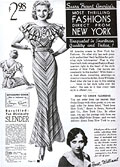 |
|
| |
 Sears
Catalogue, 1935, p. 12. Sears
Catalogue, 1935, p. 12.
|
|
| |
|
|
|
The system was not unlike that of horseracing where stables endeavoured
to
raise a herd of winning horses. For stardom to succeed it was necessary to
have
a good amount of publicity. Nothing leant itself more or better to
publicity
and advertising culture than movie stardom. The two fed off each other. A
specific
form of publicity known as the licensed image emerged during the 1930s.
The master
of this form was Walt Disney. His best-known character, Mickey Mouse, was
found
on everything from cereal boxes to toothbrushes, lampshades, and dolls.
Disney,
according to historian Gary Cross, managed a tour de force: He licensed
Snow
White and her seven associates prior to the screening of the film of the
same
name.
|
Stardom and the Catalogue
| |
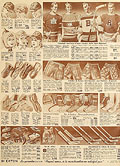 |
|
| |
 Eaton's
Fall/Winter Catalogue, 1941-42, p. 364. Eaton's
Fall/Winter Catalogue, 1941-42, p. 364.
|
|
| |
|
|
|
During the 1930s, corporate control, radio, press management, and
star-procurement
and placement in specific markets all came together to sell the game in
Canadian
professional hockey. Mail-order catalogues were an integral part of the
selling
of hockey. Although the Dupuis Frères catalogues began showing
Canadiens
and Maroons sweaters during the 1920s, NHL team sweaters and hockey
sweaters
began showing up more regularly in mail-order catalogues during the 1930s.
Favourite
numbers to sew on a hockey jersey could be ordered from the Eaton's
1934-35
catalogue.
The Simpson's catalogue of 1936-37 enthusiastically
appealed to
male youths: "Hockey sweaters in Popular Hockey Team Colours. Every
young
fellow would be mighty glad to get one of these sweaters … worn by
one
of the famous teams." Similarly, Eaton's targeted young hockey
fans
in 1941-42: "Every Canadian boy has his idol in the NHL and
wants
to have a sweater to represent his favourite team or player."
The sale of team sweaters in mail-order catalogues was one way to sell
the
game. Another was the endorsement of products by NHL stars, usually hockey
equipment.
The specialized sports catalogue of Omer de Serres featured such
endorsements
from Joe Malone and goalie George Hainsworth. In the Eaton's
fall-and-winter
catalogue of 1933-34, consumers could chose a stick autographed by
King
Clancy, Ken Deraty, or goalie Lorne Chabot. A pair of gloves was endorsed
by
the man who centred the fabled "kid line" of the Maple Leafs,
Joe
Primeau. Primeau would eventually become a regular feature on the hockey
pages
of the Simpson's catalogue endorsing sticks and other equipment, as
would
another Leafs player, Syl Apps. Eaton's, meanwhile, chose the rugged
Red
Horner to grace its mail-order hockey pages around 1937-38; he
endorsed
men's hockey skates that sold for $4.50 a pair.
The tradition of using hockey stars to endorse sporting equipment and
clothing
in the mail-order catalogue continued through the 1950s. New stars and new
French
names began to show up in the Toronto and Montreal based catalogues:
Béliveau,
Geoffrion and, above all, Maurice "Rocket" Richard. Many of
the same
stars also showed up in the Dupuis Frères catalogue. The mid-winter
catalogue
for 1951-52, for example, shows a selection of overalls,
sweatshirts, and
windbreakers, all sporting the signature and image of the Rocket.
The mail-order catalogue was just the tip of the iceberg. Richard, like
other
hockey stars, endorsed all sorts of products. He was a publicity star and
because
of this became a household name. And, of course, he and the others could
be seen
live on the television screen every Saturday night, beginning in the early
1950s.
Rocket Richard, owner of the fabled number 9 hockey sweater, played for
the
Montréal Canadiens from 1942 to 1960. Buoyed by strong endorsement
in
the media including mail-order catalogues, Richard became popular
throughout
Canada, but nowhere more so than in the province of Quebec where he was
revered
as something of a sporting god. His popularity reached out to the most
faraway
places, such as the little village of Saint-Justine, east of
Québec. Years
later during the 1970s, a former resident of Sainte-Justine set out to
capture
the importance of Richard during his childhood.
| |
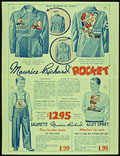 |
|
| |
 Dupuis
Frères Mid-winter Catalogue,1951-52. Dupuis
Frères Mid-winter Catalogue,1951-52.
|
|
| |
|
|
|
"I remember very well the winter of 1946. We all wore the same
uniform
as Maurice Richard … We all combed our hair like Maurice Richard
…
We laced our skates like Maurice Richard, we taped our sticks like Maurice
Richard.
We cut his pictures out of all the newspapers …
| |
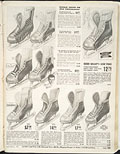 |
|
| |
 Eaton's
Fall/Winter Catalogue, 1953-54, p. 559. Eaton's
Fall/Winter Catalogue, 1953-54, p. 559.
|
|
| |
|
|
|
"On the ice … we were five Maurice Richards against five
other
Maurice Richards … We were ten players all wearing the uniform of
the Montreal
Canadian, all with the same burning enthusiasm. We all wore the famous
number
9 on our backs. How could we forget that?"
These are the opening lines of Roch Carrier's book, The
Hockey Sweater.
|
|
|
Further Reading
Cross, Gary. An All-Consuming Century: Why Commercialism Won in
Modern
America. New York: Columbia University Press, 2000.
Fowles, Jib. "Mass Media and the Star System." In
Communication
in History, Technology, Culture, Society edited by D. Crowley and P.
Heyer,
pp. 207-214. White Plains, N.Y.: Longman, 1995.
Kidd, Bruce. The Struggle for Canadian Sport. Toronto:
University
of Toronto Press, 1996.
McFarlane, Brian. The Lively World of Hockey: A History of the
National
Hockey League. Toronto: Signet Books, 1968.
Saint-Pierre, Jacques. "Le Hockey et le sport professionel dans
les
catalogues à l'époque de leur âge d'or,
1880-1960."
Unpublished manuscript, Canadian Postal Museum, 2001.
|
| |
|
|